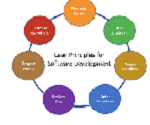SDLC Incremental Model and Phases
Introduction:
- It is a process of software development where requirements are broken down into multiple standalone modules of software cycle.
- In software engineering the incremental model is one such which combines the elements of the waterfall model in an iterative manner.
- Here multiple development cycles take place to make the life cycle a ” multi – waterfall cycle.
- Cycles are divided into smaller, to manage iterations more easily.
- The waterfall model is repeatedly applied in each increment in the incremental model of software engineering.
Phases of incremental model:
Requirement analysis
In the first step of the incremental model, the product analysis expertise identifies the functional requirements and non-functional requirements. This stage plays an important role while developing software under the gradual method.
Design & Development
In this phase of the SDLC’s incremental model, the system functionality and design of the development methodology has ended with success. When the software develops new practicality, the incremental model uses the design and development phase.
Testing
In the incremental model, the testing phase examines the performance of each existing function as well as additional functionality. In the testing phase, different methods are used to test the behavior of each task.
Implementation
In the implementation phase, coding is done for developing software. The design of the software, which is made in the designing phase, is now implemented practically, and final coding is done. Upon completion of this process, the quality of the product working will be enhanced and upgraded to the final system product.
When do we use the Incremental Model?
- When the requirements are superior.
- A project has a lengthy development schedule.
- When Software teams are not very well skilled or trained.
- When the customer demands a quick release of the product.
- You can develop prioritized requirements first.
Advantages of Incremental model:
- errors are easy to detect.
- Easy to test and debug.
- Flexible.
- Easy to manage risk because it has been managed through iteration.
- The client is provided with significant functionality at an early stage.
Disadvantages of Incremental model:
- Requires effective planning.
- Requires good design to ensure inclusion of the required functionality and provision for changes.
- It needs well-defined module interfaces.
- Well-defined module interfaces are required, as some are developed long before others are developed.
- The complete system cost is not lower.
Conclusion:
The final conclusion for our presentation is that, incremental model is a development of a system in a series partial product. It needs a clear and complete design to make this incremental model work, it is easy to manage risk because risky pieces are identified in iteration. Incremental models are cheaper than Multi-Waterfall.



